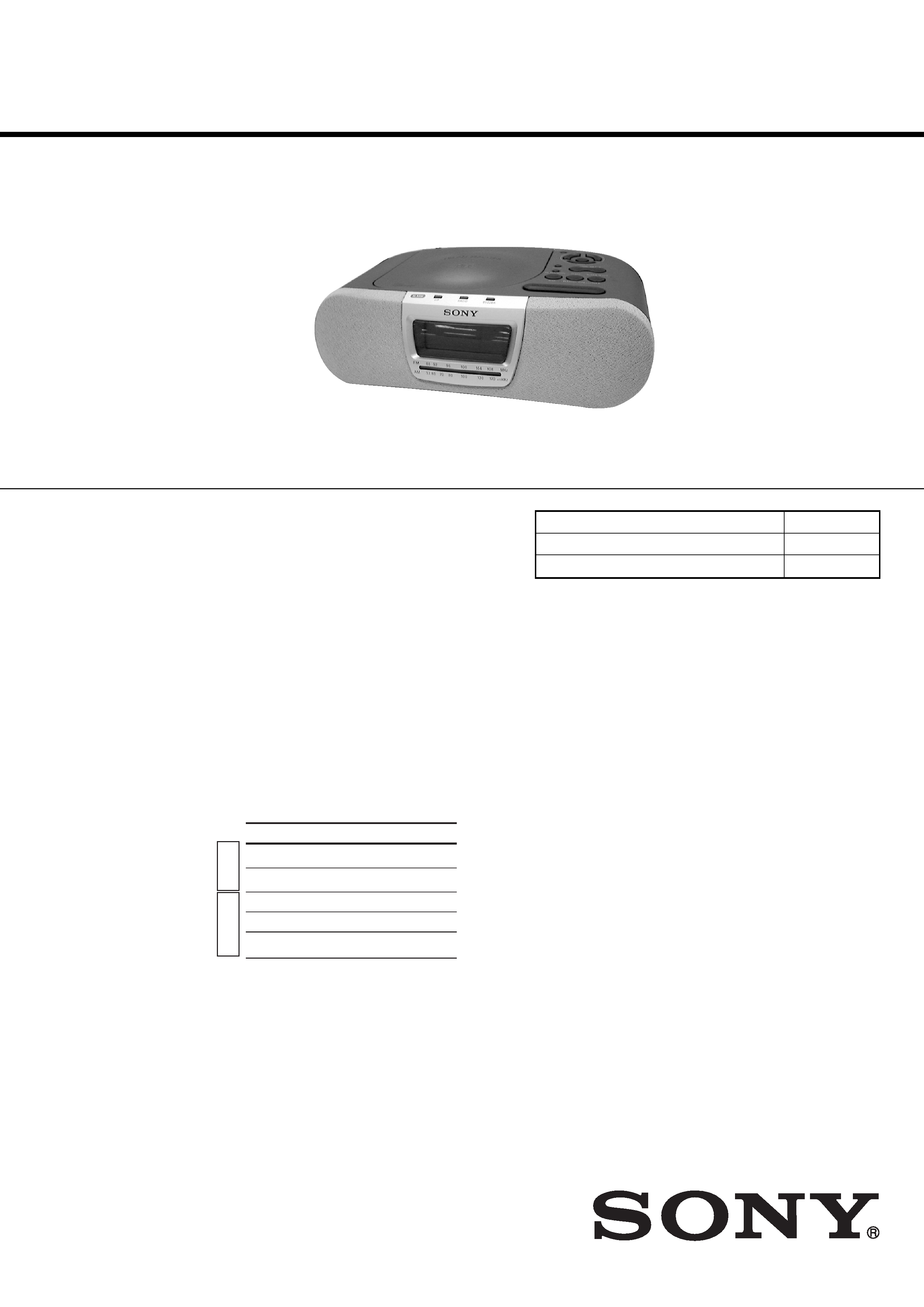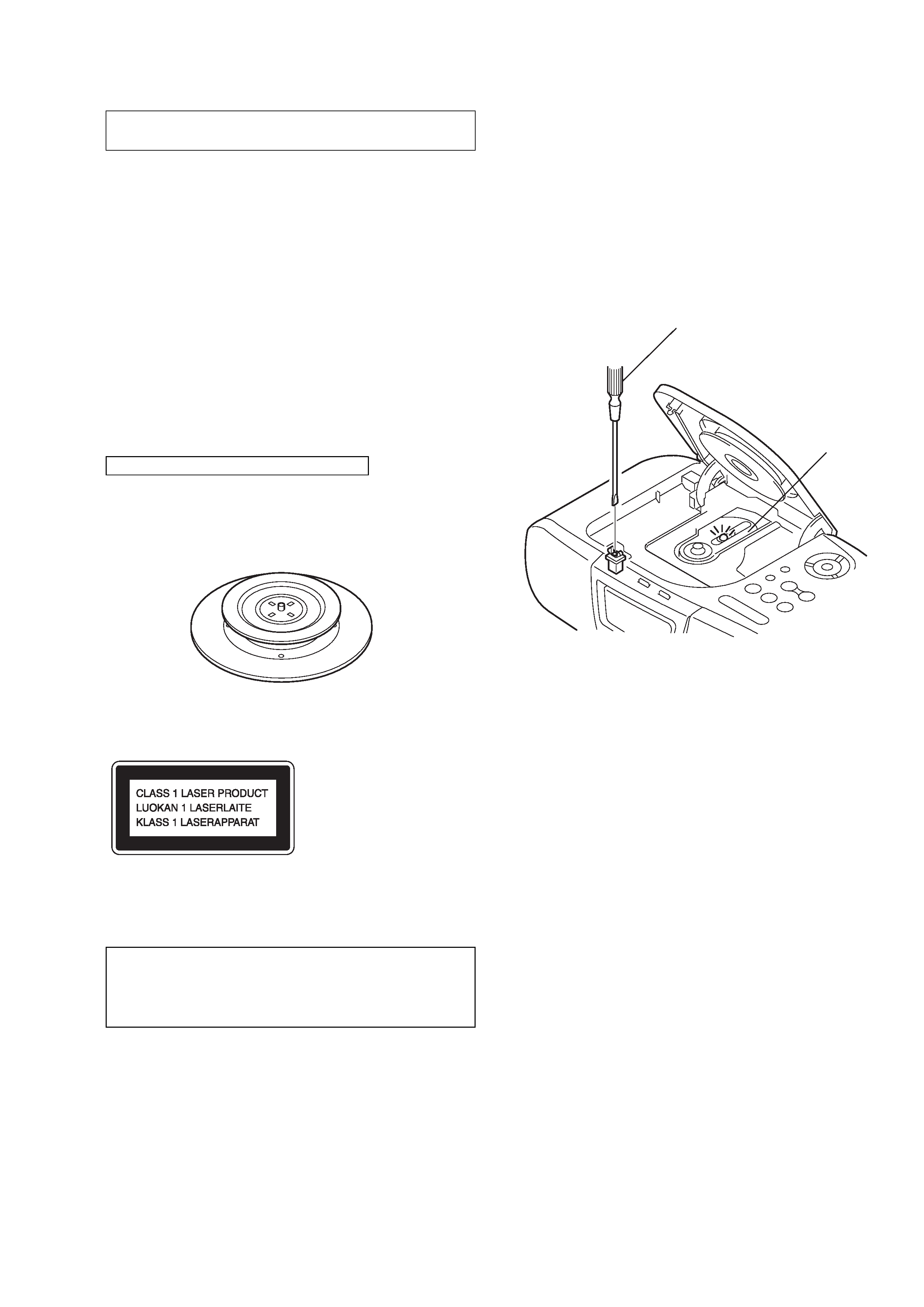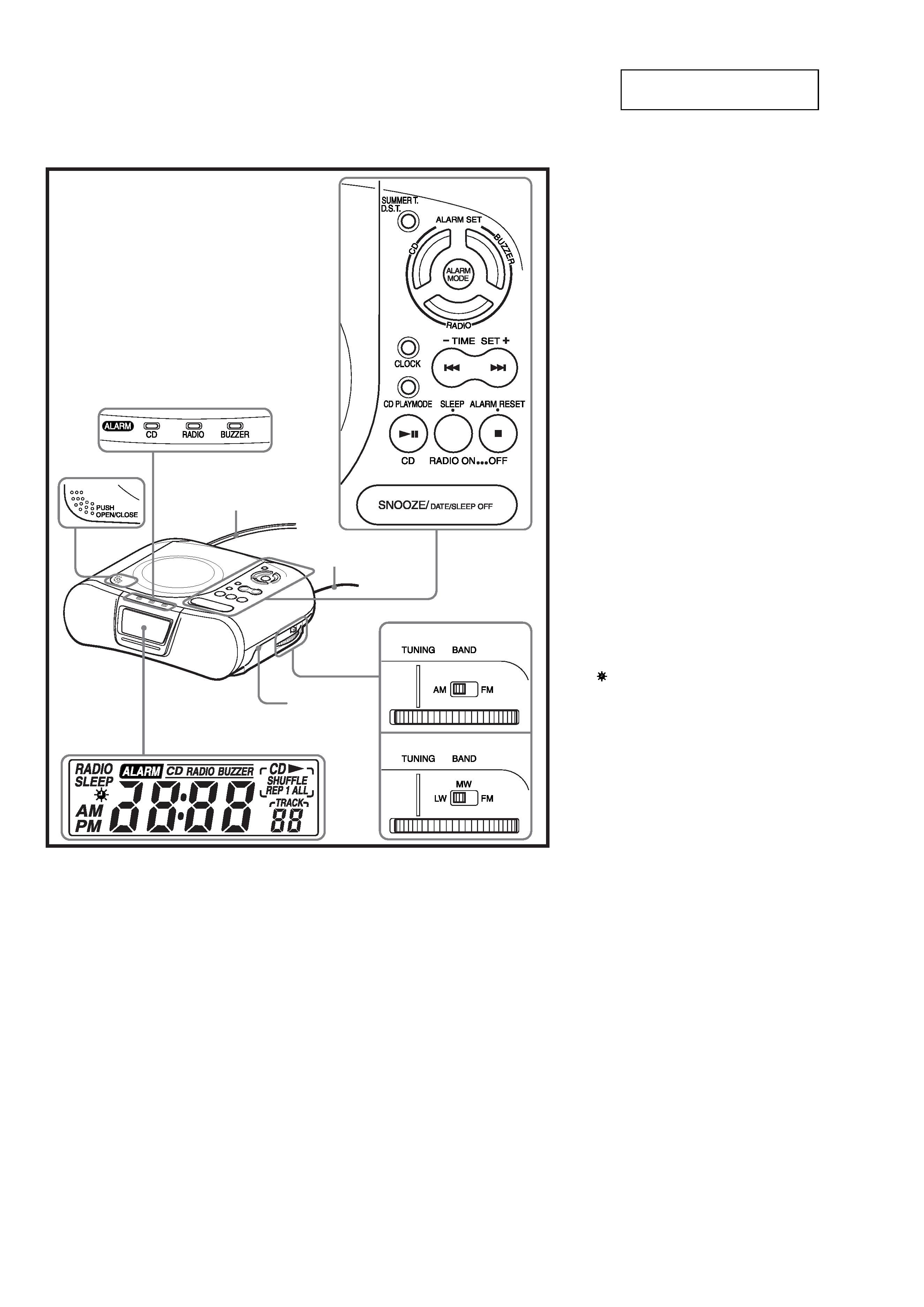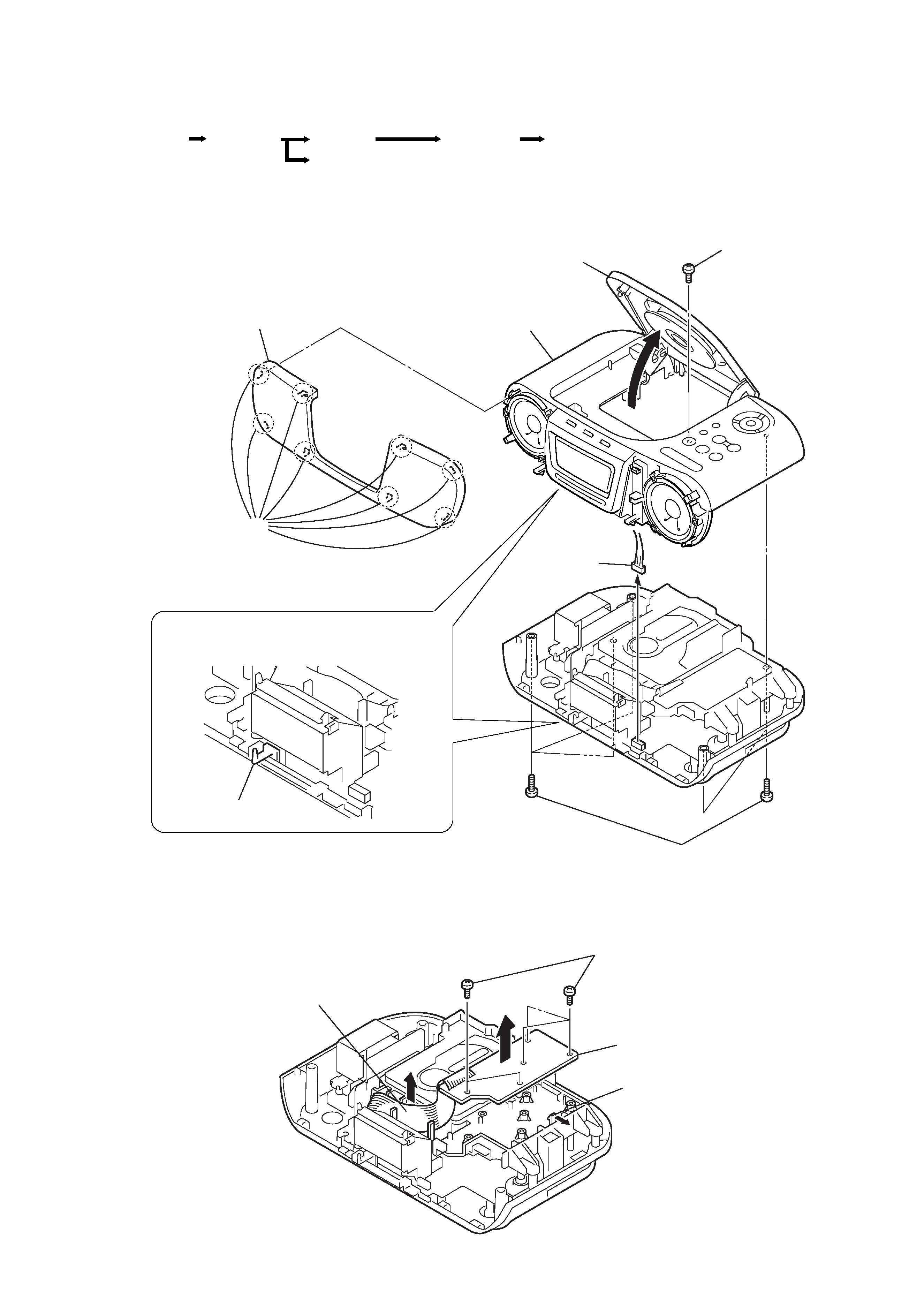
ICF-CD830/CD830L
US Model
Canadian Model
Australian Model
E Model
ICF-CD830
AEP Model
ICF-CD830/CD830L
UK Model
ICF-CD830L
SERVICE MANUAL
CD CLOCK RADIO
SPECIFICATIONS
Model Name Using Similar Mechanism
ICF-CD823
Optical Device Name
KSM-213CDM
Optical Pick-UP Name
KSS-213C
Photo : ICF-CD830
CD player section
System: Compact disc digital audio system
Laser diode properties: Material: GaAlAs
Wavelength: 780 nm
Emission duration: Continuous
Laser output: Less than 44.6
µW
(This output is the value measured at a
distance of about 200 mm from the objective
lens surface on the optical pick-up block
with 7 mm aperture.)
Frequency response: 20-20 000 Hz
+1
1.5
dB
Wow and flutter: Below measurable limit
Radio section
Frequency range:
ICF-CD830
ICF-CD830L
FM
87.5-108 MHz
AM
530-1 710 kHz
FM
87.5-108 MHz
87.5-108 MHz
AM(MW)
530-1 710 kHz
530-1 710 kHz
LW
153-255 kHz
General
Time display:
North and South America, UK and
Australia: 12-hour system
Other countries: 24-hour system
Speaker:
66 mm (2 5/8 inches) dia., 4
Power outputs:
1.2 W + 1.2 W
(at 10% harmonic distortion)
Power requirements:
North and South American model:
120 V AC, 60 Hz
Australian model:
240 V AC, 50 Hz
Other models:
220-230 V AC, 50 Hz
Dimensions:
Approx. 273
× 94.5 × 194.5 mm (w/h/d)
(Approx. 10 3/4
× 3 3/4 × 7 3/4 inches) incl.
projecting parts and controls
Mass:
Approx. 1 705 g (3 lb. 12 oz.)
ICF-CD830L (UK model):
Approx. 1 725 g (3 lb. 13 oz.)
Design and specifications are subject to change
without notice.
Other
countries
North
and
South
America
Ver 1.1 2001. 08
With SUPPLEMENT-1
Sony Corporation
Personal Audio Company
Shinagawa Tec Service Manual Production Group
9-873-107-12
2001H1600-1
© 2001.8

2
ICF-CD830/CD830L
TABLE OF CONTENTS
1. GENERAL ········································································ 4
2. DISASSEMBLY
2-1. UPPER CASE ······························································· 5
2-2. KEY BOARD ································································ 5
2-3. TRANSFORMER BOARD ··········································· 6
2-4. MAIN CHASSIS ··························································· 6
2-5. OPTICAL PICK-UP BLOCK (KSM-213CDM) ·········· 6
3. TEST MODE ······························································· 7
4. ELECTRICAL ADJUSTMENTS ····························· 9
5. DIAGRAMS
5-1. CIRCUIT BOARDS LOCATION ······························· 10
5-2. BLOCK DIAGRAM (CD830) ···································· 11
5-3. BLOCK DIAGRAM (CD830L) ·································· 12
5-4. SCHEMATIC DIAGRAM
TUNER SECTION (CD830) ································· 13
5-5. SCHEMATIC DIAGRAM
TUNER SECTION (CD830L) ······························ 14
5-6. SCHEMATIC DIAGRAM
CD SECTION ······················································· 15
5-7. SCHEMATIC DIAGRAM
POWER SECTION ··············································· 16
5-8. PRINTED WIRING BOARD
MAIN SECTION ·················································· 17
5-9. PRINTED WIRING BOARD
KEY/POWER SECTION ······································ 18
5-10. SCHEMATIC DIAGRAM
KEY SECTION ····················································· 19
5-11. IC BLOCK DIAGRAMS ············································ 20
5-12. IC PIN FUNCTION DESCRIPTION ························· 22
6. EXPLODED VIEWS
6-1. CABINET SECTION ·················································· 23
6-2. CHASSIS SECTION ··················································· 24
6-3. OPTICAL PICK-UP SECTION
(KSM-213CDM) ························································· 25
7. ELECTRICAL PARTS LIST ································· 26
ATTENTION AU COMPOSANT AYANT RAPPORT
À LA SÉCURITÉ!
LES COMPOSANTS IDENTIFIÉS PAR UNE MARQUE
! SUR
LES DIAGRAMMES SCHÉMATIQUES ET LA LISTE DES
PIÈCES
SONT
CRITIQUES
POUR
LA
SÉCURITÉ
DE
FONCTIONNEMENT. NE REMPLACER CES COM- POSANTS
QUE PAR DES PIÈCES SONY DONT LES NUMÉROS SONT
DONNÉS DANS CE MANUEL OU DANS LES SUPPLÉMENTS
PUBLIÉS PAR SONY.
SAFETY-RELATED COMPONENT WARNING!!
COMPONENTS IDENTIFIED BY MARK
! OR DOTTED LINE
WITH MARK
! ON THE SCHEMATIC DIAGRAMS AND IN
THE PARTS LIST ARE CRITICAL TO SAFE OPERATION.
REPLACE THESE COMPONENTS WITH SONY PARTS WHOSE
PART NUMBERS APPEAR AS SHOWN IN THIS MANUAL OR
IN SUPPLEMENTS PUBLISHED BY SONY.
SAFETY CHECK-OUT
After correcting the original service problem, perform the following
safety check before releasing the set to the customer:
Check the antenna terminals, metal trim, "metallized" knobs, screws,
and all other exposed metal parts for AC leakage.
Check leakage as described below.
LEAKAGE TEST
The AC leakage from any exposed metal part to earth ground and
from all exposed metal parts to any exposed metal part having a
return to chassis, must not exceed 0.5 mA (500 microampers.).
Leakage current can be measured by any one of three methods.
1. A commercial leakage tester, such as the Simpson 229 or RCA
WT-540A. Follow the manufacturers' instructions to use these
instruments.
2. A battery-operated AC milliammeter. The Data Precision 245
digital multimeter is suitable for this job.
3. Measuring the voltage drop across a resistor by means of a VOM
or battery-operated AC voltmeter. The "limit" indication is 0.75
V, so analog meters must have an accurate low-voltage scale.
The Simpson 250 and Sanwa SH-63Trd are examples of a
passive VOM that is suitable. Nearly all battery operated digital
multimeters that have a 2 V AC range are suitable. (See Fig. A)
Fig. A.
Using an AC voltmeter to check AC leakage.
Note on chip component replacement
· Never reuse a disconnected chip component.
· Notice that the minus side of a tantalum capacitor may be dam-
aged by heat.
1.5 k
0.15
µF
AC
voltmeter
(0.75 V)
To Exposed Metal
Parts on Set
Earth Ground

3
ICF-CD830/CD830L
The laser diode in the optical pick-up block may suffer electrostatic
break-down because of the potential difference generated by the
charged electrostatic load, etc. on clothing and the human body.
During repair, pay attention to electrostatic break-down and also
use the procedure in the printed matter which is included in the
repair parts.
The flexible board is easily damaged and should be handled with
care.
NOTES ON LASER DIODE EMISSION CHECK
The laser beam on this model is concentrated so as to be focused on
the disc reflective surface by the objective lens in the optical pick-
up block. Therefore, when checking the laser diode emission,
observe from more than 30 cm away from the objective lens.
NOTES ON HANDLING THE OPTICAL PICK-UP
BLOCK OR BASE UNIT
CAUTION
Use of controls or adjustments or performance of procedures
other than those specified herein may result in hazardous
radiation exposure.
This Compact Disc player is classified as a CLASS 1
LASER product.
The CLASS 1 LASER PRODUCT label is located on the
bottom exterior.
CHUCK PLATE JIG ON REPAIRING
On repairing CD section, playing a disc without the CD lid, use
Chuck Plate Jig.
· Code number of Chuck Plate Jig: X-4918-255-1
LASER DIODE AND FOCUS SEARCH
OPERATION CHECK
1. Open the CD lid.
2. Turn on S401 as following figure.
3. Confirm that the laser diode emission while observing the
objecting lens. When there is no emission, Auto Power Control
circuit or Optical Pick-up is broken.
Objective lens moves up and down once for the focus search.
Insert a precision
screwdriver and
push S401
laser diode
emission

4
ICF-CD830/CD830L
SECTION 1
GENERAL
This section is extracted from
instruction manual.
Setting the Clock
and Date
1 Plug in the clock radio.
The display will flash "AM 12:00" or "0:00".
2 Press CLOCK for a few seconds.
You will hear a beep and the year will start to
flash in the display.
3 Press TIME SET + or until the correct
year appears in the display.
4 Press CLOCK once.
5 Repeat steps 3 and 4 to set the month,
day, hour, and minute.
After setting the minute, press CLOCK to start
the counting of the seconds, and you will
hear two short beeps.
· To display the year and date, press SNOOZE/
DATE/SLEEP OFF once for the date, and within
2 seconds press it again for the year. The
display shows the date or year for a few
seconds and then changes back to the current
time.
· To set the current time rapidly, hold down
TIME SET + or .
· The clock system varies depending on the
model you own.
12-hour system: "AM 12:00" = midnight
24-hour system: "0:00" = midnight
· In step 5, when you press CLOCK after the
minute setting to activate the clock, the seconds
start counting from zero.
To change the display to the
daylight saving time (summer time)
indication
Press D.S.T./SUMMER T.
"
" is displayed and the time indication
changes to summer time.
To deactivate the summer time function, press
D.S.T./SUMMER T. again.
FM wire antenna
Antenne fil FM
AC power cord
Cordon d'alimentation
secteur
ICF-CD830
ICF-CD830L
VOLUME

5
ICF-CD830/CD830L
2-1. UPPER CASE
Note: Follow the disassembly procedure in the numerical order given.
SECTION 2
DISASSEMBLY
· The equipment can be removed using the following procedure.
2-2. KEY BOARD
4
Lid, CD
2
Panel (SP)
5
Screw (+P3
× 14)
3
Five screws (+P3
× 14)
7
Upper case
6
Connector
(CN371)
Pointer
1
Eight claws
Precaution during installation
When installing the upper case to the main section,
move the pointer to the left-most end as shown.
3
Key board
2
Hook
1
Five screws
(+P3
× 10)
4
Wire
Transformer board
Key board
Upper case
Set
Main chassis
Optical pick-up block (KSM-213CDM)
Ver 1.1 2001.08
